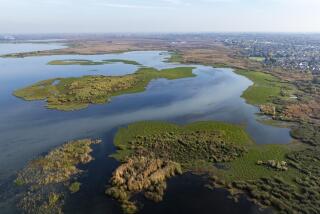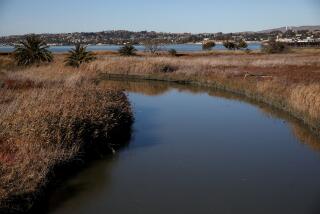Keystone XL project could harm wildlife, Interior Department says
WASHINGTON — The Interior Department has warned that the proposed Keystone XL pipeline could have long-term, damaging effects on wildlife near its route, contradicting the State Department’s March draft environmental assessment, which concluded the project would have only a temporary, indirect impact.
In a 12-page letter sent as part of the public comment on the draft assessment, the Interior Department repeatedly labels as inaccurate its sister agency’s conclusions that Keystone XL would have short-lived effects on wildlife and only during the project’s construction.
“Given that the project includes not only constructing a pipeline but also related infrastructure, access roads, and power lines and substations, impacts to wildlife are not just related to project construction. Impacts to wildlife from this infrastructure will occur throughout the life of the project (i.e. operation and maintenance phases),” the letter says.
Extending 1,700 miles from Canada’s oil sands to refineries on the Texas Gulf Coast, Keystone XL needs a presidential permit from the State Department because it crosses a U.S. border. The draft assessment focuses on the 875-mile section from the border in Montana through South Dakota to a pipeline hub in Nebraska.
The letter from the Interior Department grimly catalogs many ways Keystone XL could harm wildlife: “species displacement, increased predation rates and predator travel lanes, increased nest parasitism, vehicle collisions with wildlife … invasive plant species, increased wildfire risk, lower wildlife density, increase in collisions with power lines and electrocutions on power poles … and increase in poaching.”
The Interior Department is the second major federal agency to criticize the State Department’s draft environmental impact statement, a detailed look at the potential effects of the proposed pipeline on air, water, endangered species, communities and the economy. In April, the Environmental Protection Agency slammed the assessment, saying it failed to account for what could be considerable greenhouse gas emissions from the project and risks to aquifers along its route.
The Interior Department declined to comment on the letter, referring inquiries to the State Department.
The letter was sent April 29. But the State Department posted it to a website only last week, along with 100,000 other comments received at the same time.
“We look forward to continuing to work with the Department of Interior on the issues described in its letter,” a State Department official said, speaking on condition of anonymity to discuss differences within the administration. “The Department of State continues to review the presidential permit application for the proposed Keystone XL pipeline in a rigorous, transparent and efficient manner.”
The State Department could issue its final environmental impact statement at any time. The Obama administration must then determine whether the pipeline serves the national interest, based not just on the State Department’s analysis, but those of other federal agencies too, such as the EPA and the Interior Department.
In June, President Obama noted the pipeline’s potential effect on climate change, saying, “Our national interest will be served only if this project does not significantly exacerbate the problem of carbon pollution.”
TransCanada, the company that would own Keystone XL, said it was confident the State Department would still conclude the pipeline’s effect on the environment would be minimal.
“As our application shows, there are detailed steps we have taken to mitigate impacts on the environment, sensitive areas, wildlife and communities,” said TransCanada spokesman Shawn Howard. “There are already more than 12,000 pages of technical review that have been published on Keystone XL, and they have stated that there will be a minimal impact on environmental resources along the entire route.”
Most critics of Keystone XL have focused on the potential damage from an oil spill. The Interior Department letter warns of spills, but also highlights day-to-day negative environmental effects.
The letter cautions that birds, such as the least tern and the piping plover, could be threatened in a protected area of the Missouri River in Nebraska, about 40 miles from where Keystone XL would cross the Niobrara River. Changes in water level could affect the birds’ nesting activities, and they could be killed by flying into power lines and other new infrastructure.
The State Department draft analysis also says a fish called the pallid sturgeon would not be affected by “temporary water withdrawals” from rivers. But the Interior Department letter calls the statement unsupported.
The Interior Department also raised concern about how the pipeline might damage wetlands and archaeological sites. And it warned that Keystone XL could create light and noise pollution that could affect people and wildlife alike.
More to Read
Sign up for Essential California
The most important California stories and recommendations in your inbox every morning.
You may occasionally receive promotional content from the Los Angeles Times.











